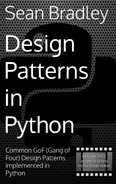Builder Design Pattern
Video Lecture
| Section | Video Links |
|---|---|
| Builder Overview |   |
| Builder Use Case |   |
| Python List |   |
Overview
The Builder Pattern is a creational pattern whose intent is to separate the construction of a complex object from its representation so that you can use the same construction process to create different representations.
The Builder Pattern tries to solve,
- How can a class create different representations of a complex object?
- How can a class that includes creating a complex object be simplified?
The Builder and Factory patterns are very similar in the fact they both instantiate new objects at runtime. The difference is when the process of creating the object is more complex, so rather than the Factory returning a new instance of ObjectA, it calls the builders' director constructor method ObjectA.construct() that goes through a more complex construction process involving several steps. Both return an Object/Product.
Terminology
- Product: The Product being built.
- Builder Interface: The Interface that the Concrete builder should implement.
- Builder: Provides methods to build and retrieve the concrete product. Implements the Builder Interface.
- Director: Has a
construct()method that when called creates a customized product using the methods of the Builder.
Builder UML Diagram
Source Code
- Client creates the Director.
- The Client calls the Directors
construct()method that manages each step of the build process. - The Director returns the product to the client or alternatively could also provide a method for the client to retrieve it later.
./builder/builder_concept.py
1 2 3 4 5 6 7 8 9 10 11 12 13 14 15 16 17 18 19 20 21 22 23 24 25 26 27 28 29 30 31 32 33 34 35 36 37 38 39 40 41 42 43 44 45 46 47 48 49 50 51 52 53 54 55 56 57 58 59 60 61 62 63 64 65 66 67 68 69 70 | |
Output
python ./builder/builder_concept.py
['a', 'b', 'c']
SBCODE Editor
Example Use Case
Using the Builder Pattern in the context of a House Builder.
There are multiple directors that can create their own complex objects.
Note that in the IglooDirector class, not all the methods of the HouseBuilder were called.
The builder can construct complex objects in any order and include/exclude whichever parts it likes.
Example UML Diagram
Source Code
./builder/client.py
1 2 3 4 5 6 7 8 9 10 11 12 13 | |
./builder/igloo_director.py
1 2 3 4 5 6 7 8 9 10 11 12 13 14 15 16 17 | |
./builder/castle_director.py
1 2 3 4 5 6 7 8 9 10 11 12 13 14 15 | |
./builder/houseboat_director.py
1 2 3 4 5 6 7 8 9 10 11 12 13 14 15 | |
./builder/interface_house_builder.py
1 2 3 4 5 6 7 8 9 10 11 12 13 14 15 16 17 18 19 20 21 22 23 24 25 26 27 28 29 30 | |
./builder/house_builder.py
1 2 3 4 5 6 7 8 9 10 11 12 13 14 15 16 17 18 19 20 21 22 23 24 25 26 27 28 | |
./builder/house.py
1 2 3 4 5 6 7 8 9 10 11 12 13 14 15 16 17 18 19 20 | |
Output
python ./builder/client.py
This is a Ice Igloo with 1 door(s) and 0 window(s).
This is a Sandstone Castle with 100 door(s) and 200 window(s).
This is a Wood House Boat with 6 door(s) and 8 window(s).
SBCODE Editor
New Coding Concepts
Python List
In the file ./builder/builder_concept.py
53 54 | |
The [] is indicating a Python List.
The list can store multiple items, they can be changed, they can have items added and removed, can be re-ordered, can be pre-filled with items when instantiated and is also very flexible.
PS> python
>>> items = []
>>> items.append("shouldn't've")
>>> items.append("y'aint")
>>> items.extend(["whomst", "superfluity"])
>>> items
["shouldn't've", "y'aint", 'whomst', 'superfluity']
>>> items.reverse()
>>> items
['superfluity', 'whomst', "y'aint", "shouldn't've"]
>>> items.remove("y'aint")
>>> items
['superfluity', 'whomst', "shouldn't've"]
>>> items.insert(1, "phoque")
>>> items
['superfluity', 'phoque', 'whomst', "shouldn't've"]
>>> items.append("whomst")
>>> items.count("whomst")
2
>>> len(items)
5
>>> items[2] = "bagnose"
>>> items
['superfluity', 'phoque', 'bagnose', "shouldn't've", 'whomst']
>>> items[-2]
"shouldn't've"
Lists are used in almost every code example in this documentation. You will see all the many ways they can be used.
In fact, a list was used in the Abstract Factory example,
if furniture in ['SmallChair', 'MediumChair', 'BigChair']:
...
This line, creates a list at runtime including the strings 'SmallChair', 'MediumChair' and 'BigChair'. If the value in furniture equals the same string as one of those items in the list, then the condition is true and the code within the if statement block will execute.
Summary
- The Builder pattern is a creational pattern that is used to create more complex objects than you'd expect from a factory.
- The Builder pattern should be able to construct complex objects in any order and include/exclude whichever available components it likes.
- For different combinations of products than can be returned from a Builder, use a specific Director to create the bespoke combination.
- You can use an Abstract Factory to add an abstraction between the client and Director.
































